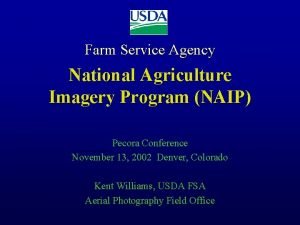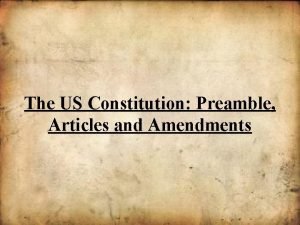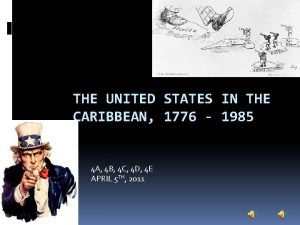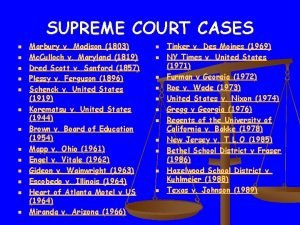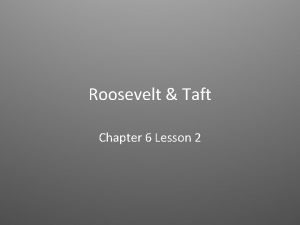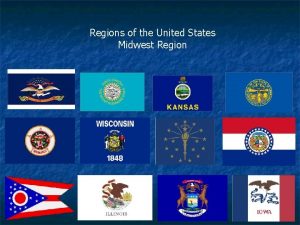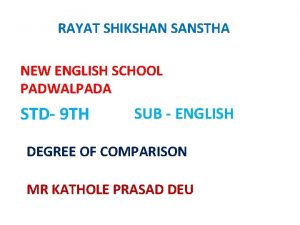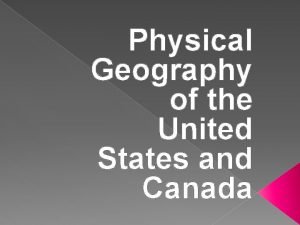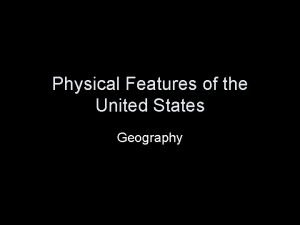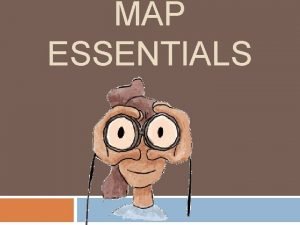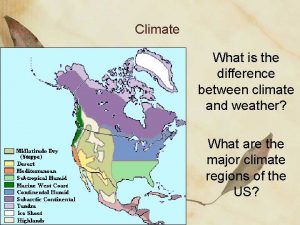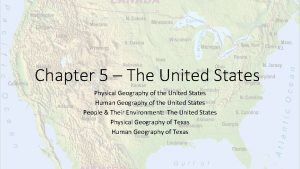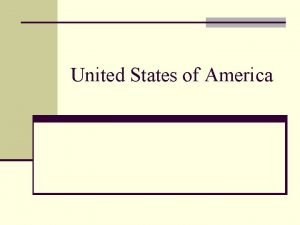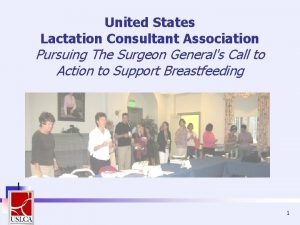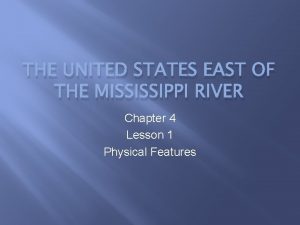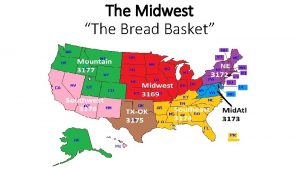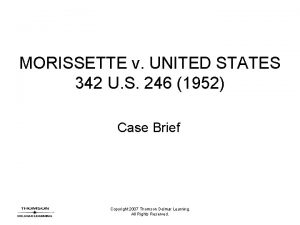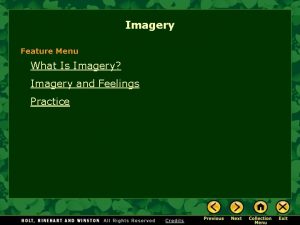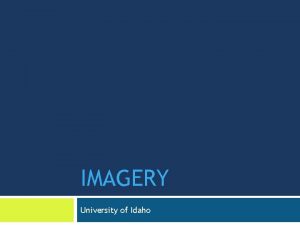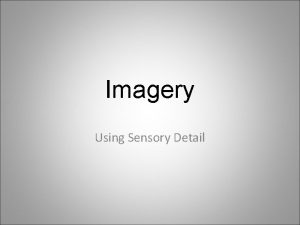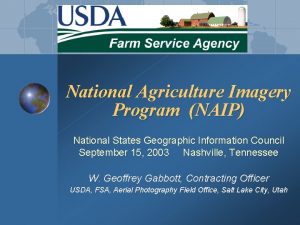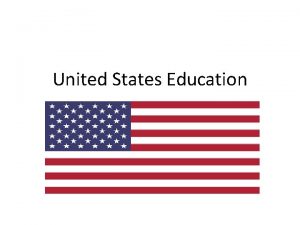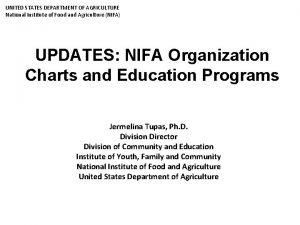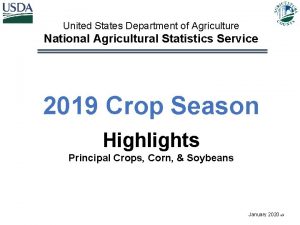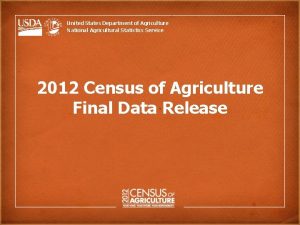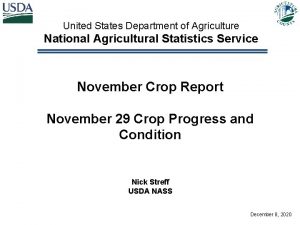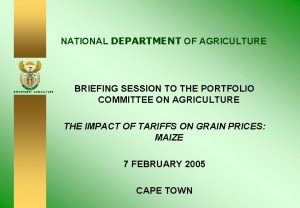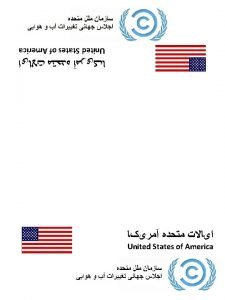United States Department of Agriculture National Agriculture Imagery











































- Slides: 43

United States Department of Agriculture National Agriculture Imagery Program NAIP Accuracy JACIE November 17, 2020 David Davis USDA – FPAC BC – GEO Farm Production and Conservation FSA | NRCS | RMA | Business Center

United States Department of Agriculture NAIP National Agriculture Imagery Program Farm Production and Conservation FSA | NRCS | RMA | Business Center

United States Department of Agriculture Early FSA Aerial Photography • Experimented with aerial photography to measure farm fields in 1934 & 1935 • Two photo labs created in 1937 (merged in 1962) which produced 24”x 24” rectified enlargements • Tract and field boundaries were drawn directly onto the enlargements • In late 1970 s, county offices began using 35 mm cameras to acquire “peak growth” compliance imagery • Projected onto the 24”x 24” enlargements • Estimated over a billion 35 mm slides were produced Farm Production and Conservation FSA | NRCS | RMA | Business Center

United States Department of Agriculture Origin of NAIP • In the 1990 s, Farm Service Agency considered the use of GIS and digital aerial imagery to replace the paper enlargements • APFO started creating Mosaicked Digital Ortho (MDOQ) in 1997 using the National Aerial Photography Program (NAPP) imagery • Attributes on the old 24”x 24” enlargements were digitized to create the Common Land Units (CLUs) Farm Production and Conservation FSA | NRCS | RMA | Business Center

United States Department of Agriculture Initial Plan • Started in 2003, after 2002 pilot • Annual, leaf-on 2 m collection of agricultural areas only (as defined by the CLUs) • Replacement for the 35 mm compliance imagery • Full state 1 m “replacement” base imagery collected every 5 -years Planned (Pre-Award) • Higher resolution need to update CLUs • Horizontal accuracy tied to original MDOQs • Dual use: Leaf-on to allow compliance use • Partners allowed to “buy up” Farm Production and Conservation FSA | NRCS | RMA | Business Center

United States Department of Agriculture National Agriculture Imagery Program • Largest, longest running consistent airborne-based civilian program • Spatial Resolution – 1 m (all states since 2008) & 60 cm ground resolution (2018) • Spectral Resolution – Natural Color and False Color Infrared (all states since 2010) • Refresh – two-year CONUS collection cycle since 2008; changed to three-year in 2018 • Acquisition Period – Leaf-on during peak agriculture growth • Historically FSA has funded approximately 2/3 of imagery acquisition cost and 100% of project execution cost. • Public Domain dataset Farm Production and Conservation FSA | NRCS | RMA | Business Center

United States Department of Agriculture Farm Production and Conservation FSA | NRCS | RMA | Business Center

United States Department of Agriculture Farm Production and Conservation FSA | NRCS | RMA | Business Center

United States Department of Agriculture https: //www. fsa. usda. gov/Assets/USDA-FSA-Public/usdafiles/APFO/status-maps/pdfs/naip_cov_2019. pdf Farm Production and Conservation FSA | NRCS | RMA | Business Center

United States Department of Agriculture NAIP Accuracy Specifications • 2002 -2005: “The accuracy standard for the 1 -meter orthorectified images requires that 90% of all well-defined points tested must fall within three (3) meters of the same location identified on Government furnished baseline orthophoto control imagery”. • 2006 -2011: “ 95% of well-defined points tested shall fall within 6 meters of true ground” • 2012 - 2015: “Unless otherwise specified in the individual task order, all well defined points tested on DOQQ titles shall fall within 6. 0 meters of true ground at a 95% confidence level (see FGDC-STD-007. 3 -1998, page 3 -10)”. • 2016: Changed from 6 meters to 4 meters. Farm Production and Conservation FSA | NRCS | RMA | Business Center

United States Department of Agriculture NAIP Accuracy Inspection • The NAIP horizontal accuracy inspection process evaluates the positional accuracy of NAIP imagery against known control points (with well-defined x and y coordinates). This is done by using a photo identifiable control point which includes descriptions of the point locations and matching those to the physical location on the NAIP imagery. The x- and y-component error distance are calculated from the known control point and the “inspection” point. After all control points have been measured, a root-meansquare error (RMSE) is used to estimate the positional accuracy. The final horizontal accuracy assessment is calculated using the Case 1 formula in the FGDC-STD-007. 3 -1998, Appendix 3 A specification. The calculations assume that horizontal errors are normally distributed with no systematic errors or biases present. Farm Production and Conservation FSA | NRCS | RMA | Business Center

United States Department of Agriculture NAIP Accuracy Inspection • In house inspection by FPAC BC GEO specialists using custom routines with Arc. GIS Pro software • In addition to horizontal accuracy, various image quality items are evaluated such as: clipping, contrast, histogram mean, color balance, cloud coverage, artifacts, offsets, missing data, missing pixels, specular reflection, foreign materials, coverage, etc. • Reports are produced Farm Production and Conservation FSA | NRCS | RMA | Business Center

United States Department of Agriculture NAIP 2018 & 2019 Inspections • 2018 • 12406 GCPs reviewed in 25 states • Average accuracy of 2. 24 meters • State Min 2. 09, Max 3. 91 meters • 2019 • Average accuracy of 1. 80 meters • State Min 0. 76, Max 3. 38 Farm Production and Conservation FSA | NRCS | RMA | Business Center

United States Department of Agriculture NAIP 2018 & 2019 Reports Farm Production and Conservation FSA | NRCS | RMA | Business Center

United States Department of Agriculture Ground Control Point Database Farm Production and Conservation FSA | NRCS | RMA | Business Center

United States Department of Agriculture Relative or Absolute Control Relative control Use existing imagery with known qualities as a base. Compare new imagery to base image and note the difference. Absolute control Photo-identifiable ground control points are used as a base. Difference is measured between location on photo and GCP. Farm Production and Conservation FSA | NRCS | RMA | Business Center

United States Department of Agriculture NAIP - Why relative control? (pre 2006) • Vector data was digitized on mosaicked USGS DOQQs. By matching the NAIP imagery to the MDOQs, the existing vector data should match the new NAIP. • A non-commercial, nationwide, photo-identifiable, standardized, Ground Control Point (GCP) database was not available. • GCP databases or combined datasets do exist BUT often are NOT photo-identifiable on 1 -meter aerial imagery, not standardized, not available from a single source, not shareable, not available at little/no cost. Farm Production and Conservation FSA | NRCS | RMA | Business Center

United States Department of Agriculture NAIP - Why relative control? (pre 2006) • Potentially easier and faster to inspect the imagery. • Potentially easier and faster for vendors to produce imagery. Use prior imagery as control for orthoimage production. • Relative control can work well for checking large amounts of imagery in a short amount of time. Farm Production and Conservation FSA | NRCS | RMA | Business Center

United States Department of Agriculture Why not use relative control? • Building error upon error. Horizontal accuracy level of USGS DOQQs is about 10 -m. Up to an additional 5 -m offset between NAIP and MDOQs. Even more potential error when comparing new NAIP to prior NAIP. • Vector data and NAIP may match well but often not other vector layers or imagery. • Potentially more work and more costly for vendors to create imagery that matches MDOQ imagery instead of using traditional methods with control points. Farm Production and Conservation FSA | NRCS | RMA | Business Center

United States Department of Agriculture Why not use relative control? • Vendors potentially had to introduce error into the new NAIP imagery so that it matched the MDOQ imagery. • Funding partners noted offsets of NAIP and their data. • FSA and partner agencies requested absolute control. • Advance NAIP program to industry accuracy standards. • Through lots of research, contacts, and data provided by many agencies and organizations, APFO has been able to create a GCP database for NAIP imagery inspection. Farm Production and Conservation FSA | NRCS | RMA | Business Center

United States Department of Agriculture APFO Ground Control Basics • Ground control used by GEO for inspecting the horizontal accuracy of NAIP and other imager • Most GCPs are on manmade, permanent features. Maintained targets, vegetation, or other temporary or semi-permanent features can also be used. • Basic Requirements • • • Photo identifiable on 1 -meter imagery Accuracy of 30 -cm or better, accept up to 1 -m Support info (description, photos, sketches, …) • Data acquired from many sources • GEO GCP data is not made available to the public, to ensure an independent data inspection. Farm Production and Conservation FSA | NRCS | RMA | Business Center

United States Department of Agriculture A brief history of NAIP control … • 2006 1 state, Utah (pilot project) – GCPs provided to vendor for production • 2007 1 state, Arizona (pilot project) – GCPs provided to vendor for production • 2008 Half & Half of states used GCPs and half used the relative control method – GCPs IN, MN, NH, NC, TX, VT, VA • 2009 to present – All states flown for NAIP have used absolute control for inspection Farm Production and Conservation FSA | NRCS | RMA | Business Center

United States Department of Agriculture Control Point Database • • • 2008 – 7, 302 2009 – 31, 055 2010 – 37, 902 2011 – 38, 618 2012 – 2020 +/- 40, 000 Estimated value of >12 Million Dollars if all GCPs had been purchased from a commercial vendor. Based on $300 per GCP. A conservative amount, particularly for areas such as Alaska. Farm Production and Conservation FSA | NRCS | RMA | Business Center

United States Department of Agriculture ¿Questions? Farm Production and Conservation FSA | NRCS | RMA | Business Center

United States Department of Agriculture Point of Contact David Davis Geospatial Enterprise Operation (GEO) Branch Information Solutions Division (ISD) FPAC Business Center 801 -844 -2933 david. davis@usda. gov Farm Production and Conservation FSA | NRCS | RMA | Business Center

United States Department of Agriculture NAIP GCP Discussion Items JACIE November 19, 2020 David Davis USDA – FPAC BC – GEO Farm Production and Conservation FSA | NRCS | RMA | Business Center

United States Department of Agriculture Creating a GCP database • Existing data • Existing standards • Requirements (accuracy, photo-identifiable, support info, …) • New data • Custom standards • Leaders, coordinators, participators, users, … • Database (type, where, who, how, …) • Access to data, permissions, … Farm Production and Conservation FSA | NRCS | RMA | Business Center

United States Department of Agriculture Database • Information (x, y, z; accuracy, FIPS, state, county, regular & hi-res, description, support data, … • Support info in database or linked to database • Database type: Excel, Oracle, etc. • Naming conventions , metadata, accuracy, contacts, date, GPS device/software info, … • Different accuracy or other requirements for different uses • Manager, permissions, access, sharable, … • Review. Our inspection personnel rank the quality of the GCPs during the image inspection process. Points marked as marginal or unusable are reviewed by the database manager. Points are removed by manager if no longer identifiable or usable. Farm Production and Conservation FSA | NRCS | RMA | Business Center

United States Department of Agriculture Support information • Photos, maps, screen shots, drawings, OPUS, descriptions, GPS files, … • File size limits (especially photos) • Data formats • How to store, how to access, naming, … • Verify that support data matches location • Include sufficient details. e. g. Intersection (center, specific corner or road, … ) • Be specific: NE corner sidewalk, not “school” Farm Production and Conservation FSA | NRCS | RMA | Business Center

United States Department of Agriculture Expert Advice • USGS, USDA, NGS, DOT, other agencies • State, county, local, tribal, cadastral agencies • National and State groups: NSGIC, ASMC, … • Professional organizations: ASPRS, URISA, … • Surveying, mapping, aerial imagery organizations and companies • Journals, reports, … Farm Production and Conservation FSA | NRCS | RMA | Business Center

United States Department of Agriculture Use of points • Creating orthophotos, inspecting data, elevation, all, some, other • Hybrid model, different GCPs may have different purposes and/or access • GCPs available to all, only for inspection, hybrid • Vendors responsible for their own GCP needs, GCPs provided to vendors • Share GCPs with certain organizations but not vendors Farm Production and Conservation FSA | NRCS | RMA | Business Center

United States Department of Agriculture How many GCPs are needed? • Required number of points (per photo, DOQQ, county, state, other? • Accuracy (NSSDA, ASPRS, other) • 90, 95 % • Changes in wording and methodology Farm Production and Conservation FSA | NRCS | RMA | Business Center

United States Department of Agriculture Form a good team • You cannot do this by yourself • Roles and responsibilities • Authority • Communication • Meetings Farm Production and Conservation FSA | NRCS | RMA | Business Center

United States Department of Agriculture Requirements • What do you need to be able to do with the data? • Can the data be multifunctional? • Accuracy, photo-identifiable, … • Permanent and/or temporary markers • Maintaining GCP, especially for painted markers • Target size and type • Control Requirements Report - Alaska Statewide Digital Mapping Initiative Farm Production and Conservation FSA | NRCS | RMA | Business Center

United States Department of Agriculture Existing Data • Free • May not meet all of your needs • May require little or lots of work to fit your database • Can require a lot of review, may only get a few usable GCPs from hundreds of points • Data may be free but may involve substantial costs of time and effort • May be hard to find and/or acquire Farm Production and Conservation FSA | NRCS | RMA | Business Center

United States Department of Agriculture New Data • Can be expensive, especially in remote, hard to get to places (AK) • May or may not easily fit into your database • Purchase from geospatial companies • Collect the data yourself (time and travel, equipment, software, processing, data ingestion, …) • May be free or purchased • Try to coordinate with existing collections Farm Production and Conservation FSA | NRCS | RMA | Business Center

United States Department of Agriculture Collecting points yourself • Extensive planning before you leave • Preselect specific sites or areas, screen shots, access (roads, trails, …), route, travel times • Map existing GCP locations, quality, age, identifiability, • Try to acquire GCPs in spots where data is lacking, poor accuracy, not identifiable, … • Carefully select sites (public access, permissions, restricted areas, … • Notify property owners, organizations, schools, etc if you plan to travel through and/or collect data • Identify yourself (vest, shirt, vehicle with logo or ID) • Suitable GPS equipment, software, training, menus, … Farm Production and Conservation FSA | NRCS | RMA | Business Center

United States Department of Agriculture Coordination • Someone with enthusiasm • Hold teleconferences, create agenda, provide contact info, training/info materials, • Be available for meetings with other agencies • USGS, NGS, State, local, city, other organizations • NSGIC, URISA, other national organizations • State: Varies from state to state • Contact everyone you know and ask for contacts • Methods for receiving data (FTP, media, mail, … ) Farm Production and Conservation FSA | NRCS | RMA | Business Center

United States Department of Agriculture Coordinate with existing GCP and cadastral programs • When working with other agencies and/or existing acquisition often not necessary to change much. Just see if adding a photo, making sure it’s photo-identifiable, etc can meet the needs of the existing program and your GCP requirements. • Emphasize that providing GCPs ensures more accurate data which in turn helps everyone that directly or indirectly uses the data • In the case of NAIP, more and better GCP data means better imagery for FSA and everyone that uses NAIP Farm Production and Conservation FSA | NRCS | RMA | Business Center

United States Department of Agriculture Appreciation • Thank everyone that helps or tries to help you • Remember, in most cases people do not have to help you • Whether you receive no useful data or hundreds of valuable points be grateful and express appreciation • When appropriate, send individual letters of appreciation (letter and email). CC supervisors of contributors. Farm Production and Conservation FSA | NRCS | RMA | Business Center

United States Department of Agriculture Language, culture, customs • There may be occasions when coordinating with or requesting data that it can be helpful to know or have contacts that understand the unique customs, processes, protocols, language, etc. • Examples: GCPs from an AZ tribal government and cadastral data from an agency in Puerto Rico • There may be concerns about why you are collecting the data Farm Production and Conservation FSA | NRCS | RMA | Business Center

United States Department of Agriculture Training/Info Materials • Single sheet with the basic info and contacts • More detailed document, examples, contacts, • Webinar, teleconference, website(s) • NAIP GCP requirements doc: http: //www. fsa. usda. gov/Internet/FSA_File/naip_cpr_final. pdf • NAIP GCP spreadsheet example: http: //www. fsa. usda. gov/Internet/FSA_File/scntrlpttable. pdf. p df Farm Production and Conservation FSA | NRCS | RMA | Business Center

United States Department of Agriculture ¿Questions? Farm Production and Conservation FSA | NRCS | RMA | Business Center
 National agriculture imagery program
National agriculture imagery program Us national symbols
Us national symbols Was the united states on the axis powers or allied powers?
Was the united states on the axis powers or allied powers? Many _____ people have settled in this megalopolis.
Many _____ people have settled in this megalopolis. 36 30 line
36 30 line Soccer league hierarchy
Soccer league hierarchy United states v. nixon significance
United states v. nixon significance United states student association
United states student association The united states ought to provide a universal basic income
The united states ought to provide a universal basic income The preamble of the constitution
The preamble of the constitution The united states in the caribbean 1776-1985
The united states in the caribbean 1776-1985 Southeast region physical features
Southeast region physical features Expansion of the united states of america 1607 to 1853 map
Expansion of the united states of america 1607 to 1853 map When did nicholas novikov write the telegram
When did nicholas novikov write the telegram Previous owner of texas
Previous owner of texas What is the message
What is the message Mapp v. ohio
Mapp v. ohio Why did the united states invade cuba in 1898?
Why did the united states invade cuba in 1898? Northern securities vs united states
Northern securities vs united states Midwestern region of the united states
Midwestern region of the united states 7 regions of the united states
7 regions of the united states The united states is the greatest buyer positive degree
The united states is the greatest buyer positive degree United states and canada physical map
United states and canada physical map United states physical geography
United states physical geography World map with longitude and latitude lines
World map with longitude and latitude lines Fifty united states
Fifty united states Chapter 2 free enterprise in the united states
Chapter 2 free enterprise in the united states Perceptual regions of the united states
Perceptual regions of the united states Where did clowns originate from
Where did clowns originate from Subtropical united states
Subtropical united states What are the social classes in the united states
What are the social classes in the united states Physical geography of the united states
Physical geography of the united states Ibn-tamas v. united states
Ibn-tamas v. united states Theme of the short story when mr pirzada came to dine
Theme of the short story when mr pirzada came to dine United states government: principles in practice solutions
United states government: principles in practice solutions What is the geographical position of the united states
What is the geographical position of the united states United states lactation consultant association
United states lactation consultant association What is the highest court in the united states? *
What is the highest court in the united states? * States east of mississippi
States east of mississippi Breadbasket of the us
Breadbasket of the us Immigration to the united states
Immigration to the united states United states v. cruikshank apush
United states v. cruikshank apush Morisette v us
Morisette v us What did manifest destiny do
What did manifest destiny do
